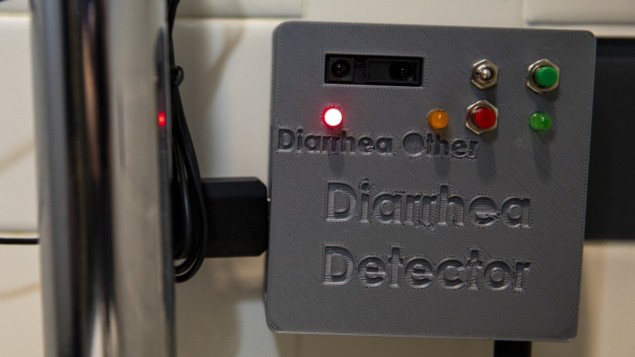The physics of toilets: scientists are flushed with success
09 Dec 2022 Hamish Johnston
Listening in: the diarrhoea sensor installed over a toilet. (Courtesy: Maia Gatlin)
This week’s Red Folder focuses on that humble yet crucial appliance, the toilet.
Cholera, a bacterial disease that causes diarrhoea, affects millions of people worldwide and results in some 150,000 deaths per year, so identifying it early could help mitigate its spread. Yet monitoring cholera outbreaks and other bowel diseases that can cause diarrhoea is tricky.
Step forward engineer Maia Gatlin of the Georgia Institute of Technology and colleagues, who have created a non-invasive microphone sensor that can pick up and analyse so-called “excretion events”. The team transformed audio samples of a bowel movement into a spectrogram and then fed this into a machine-learning algorithm that learned to successfully classify each event based on its features – such as a singular tone for a defecation and more random tones for diarrhoea. The team now plans to gather real-world acoustic data so that their machine-learning model can work in a variety of bathroom environments. Sounds grim.
Gatlin presented her results at the 183rd Meeting of the Acoustical Society of America, which was held this week in Nashville, Tennessee.
Gatlin and colleagues are not the only toilet researchers at Georgia Tech. Shannon Yee leads the Reinvent the Toilet Challenge, which aims to create a toilet that needs neither inlet water nor an outlet connection to a sewer system. The aim is to improve sanitation in places where sewerage is not available, and human waste is disposal is done on a household-by-household basis.
Pathogens on the rise
The COVID-19 pandemic has made many of us aware that virus particles and other nasties in faecal matter can be launched into the air when a toilet is flushed. While scientists have known this for at least 60 years, the nature of these noxious plumes had been poorly understood.
Now, researchers at the University of Colorado in Boulder have focused lasers on a flushing toilet to find out more. They used a type of toilet that is typical of a North American public convenience – no lid and a horseshoe-shaped seat. One laser illuminated the toilet continuously while the other fired pulses of light. Two cameras viewed the toilet and the set-up allowed the researchers to track the aerosol water droplets that were thrown up when the toilet was flushed.
“We had expected these aerosol particles would just sort of float up, but they came out like a rocket,” says Colorado’s John Crimaldi. Indeed, the droplets shot out of the toilet at 2 m/s and reached a height of 1.5 m – which is about face height for some people (apologies for another grim concept).
Sticking around
While larger droplets fall out the air very quickly, smaller ones remain suspended for several minutes. And potential pathogens get more than one chance to be airborne, because previous research has shown that they can persist in the pan over several flushes.
The research agrees with a previous study that used a handheld particle counter and suggests that some serious thought should be devoted to the design and ventilation of public toilets and cubicles to minimize the spread of disease. Crimaldi and colleagues report their results in Scientific Reports.

Hamish Johnston is an online editor of Physics World
from physicsworld.com 12/12/ 2022

Δεν υπάρχουν σχόλια:
Δημοσίευση σχολίου